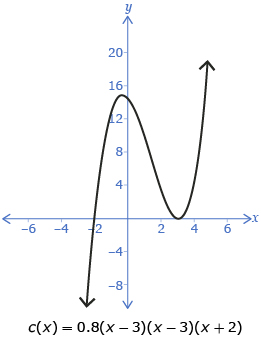Lesson 1
1. Lesson 1
1.10. Explore 6
Module 3: Polynomial Functions
In Try This 3 you may have discovered that the number of times a factor is duplicated affects the graph’s behaviour around the corresponding x-intercept.
- If a factor is repeated an odd number of times, the function changes sign (the graph crosses the x-axis) at the corresponding x-intercept.
- If a factor is repeated an even number of times, the function does not change sign (the graph touches but does not cross the x-axis) at the corresponding x-intercept.
Consider the function c(x) = 0.8(x − 3)(x − 3)(x + 2). The factor x + 2 is repeated an odd number of times, so the function changes sign at the corresponding x-intercept (x = −2). The factor x − 3 is repeated an even number of times, so the function does not change signs at the corresponding x-intercept (x = 3).
Mathematicians would say that the factor x − 3 has a multiplicity of 2 and that the factor x + 2 has a multiplicity of 1.

Read “Example 1” on pages 138 and 139 of the textbook for two more examples concerning multiplicity of factors and x-intercepts. Pay particular attention to
- “multiplicity (of a zero)” in the left column (Notice how the graph “flattens” near an x-intercept of multiplicity 3.)
- the analysis of the least possible degree of the polynomial